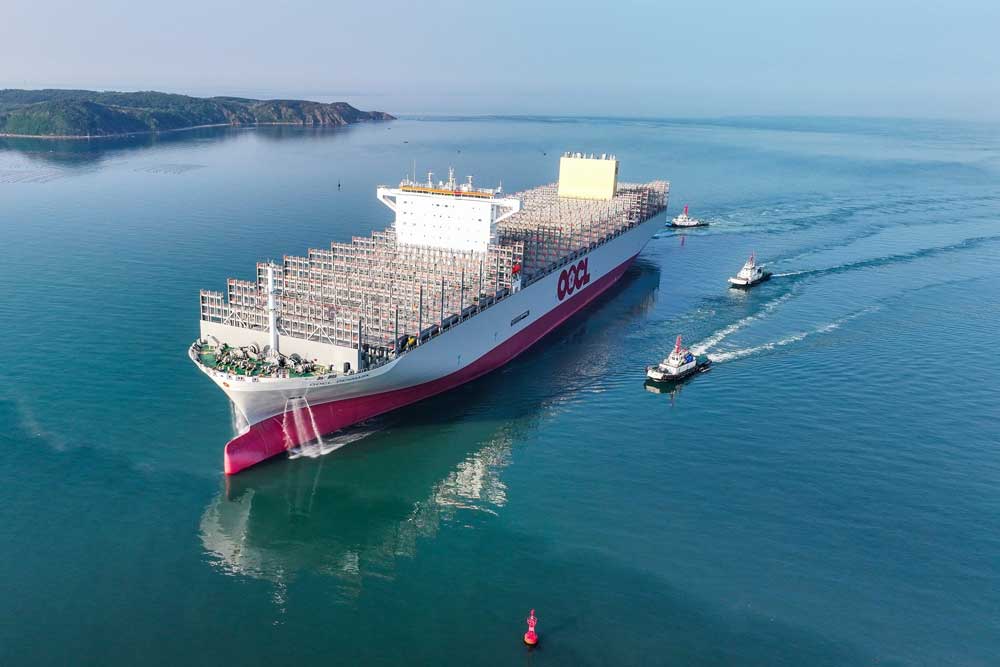There was only one direction for spot rates in the dry cargo business on the spot market this week: downwards. The biggest losers were the capesize freighters.
While container shipping is experiencing a renewed rate boom due to the crisis in the Red Sea, the market trend for bulkers has increasingly been pointing in exactly the opposite direction since this week. The Baltic Dry Index slumped by almost a third to 1,460 points (-650). [ds_preview]
Detour of voyages around the southern tip of Africa to avoid attacks by Houthi rebels have so far had no effect on bulker rates. Not even in regions such as the Mediterranean, the Black Sea or the Persian Gulf, where at least a large part of the trade passes directly through the Red Sea. Nor does the security crisis appear to be triggering any anticipation of purchasing decisions or even hoarding of bulk commodities.
Capesize rates on the spot market are falling
In the capesize sector, the long-standing tonnage shortage in the North Atlantic is no longer sufficient to support the market. In the Pacific and South Atlantic (Brazil, West Africa), charter demand has fallen so significantly compared to the previous week that the few active charterers have clearly had the upper hand, brokers reported. The average rate for the 180,000-tonner (5TC) plummeted by 43% compared to the previous week to just over 18,000 $/day.
In the Panamax segment, pressure on rates increased massively despite a relatively lively start in the North Atlantic. The average level (5TC) in the time charter trip business fell by 15% over the week to around 12,700 $/day. According to the market, there is currently a lack of volume in coal chartering in Asia on the one hand and grain in South America on the other, where the peak season does not start until February/March.
Smaller bulkers are also suffering on the spot market
The smaller freighters with their own cranes were also unable to escape the negative trend. In particular, the cooling of demand in the Atlantic loading regions, where business was still booming at the end of 2023, is leading to further rate corrections. The average rates for supramaxes and handysize bulkers fell by 10% and 11% respectively to just under USD 12,000 and USD 11,089/day.
The market for cell phones fell sharply, particularly on the continent, in the West Sea and on the east coast of South America. While the supply of cargoes in Europe has fallen sharply in the short term, South America (east coast) is suffering above all from the influx of tonnage in ballast, it is reported. The index level for the trade from Rio/Recalada to Europe has fallen from almost 19,000 to 15,200 $/day since last week.
More demand on the shortsea market
The week was more successful for shipowners in the European shortsea trade. Charter demand rose sharply, particularly in Northern Europe (Continental/North Sea) and the Western Mediterranean, as traders and charterers/operators returned to the market after the Christmas break.
At the same time, the availability of shipping space is limited due to delays caused by the cold temperatures. The spot supply of shipping space has reportedly fallen significantly, but rates have not yet picked up.
The BMTI’s European Short Sea Index (EUSSIX) moved sideways at 30.44 points. Norwegian broker Norbroker left its estimate for the yield (TCE) of the 3,500-tonne spot trade unchanged at a solid €3,800/day. “The outlook for the coming weeks is good,” noted a UK broker.
Container rates are on the rise
The container markets, which are running out of tonnage due to the longer transport routes avoiding the Red Sea, saw an upward trend across the board. The SCFI spot freight index for liner services ex Far East rose sharply again today by 16%. The charter market also saw an upward trend as carriers require more and more extra loaders to handle their booked cargoes. The New Contex rose by a significant 7% compared to the previous week.
Rates for crude oil tanker chartering also rose noticeably. However, brokers report that the reason for this was not so much the disruptions in transit through the Red Sea, but the generally high export volumes from the Atlantic, especially the US Gulf. The average spot earnings of VLCCs improved by a third compared to the previous week to $57,900/day.
In the Suezmax segment, the level remained stable at 58,100 $/day. Aframaxes increased by almost 20% to $70,800/day, according to Clarksons – driven by high inquiries in the US Gulf and a shortage of tonnage in the Mediterranean due to increasing transit delays in the Turkish Straits. (mph)
















